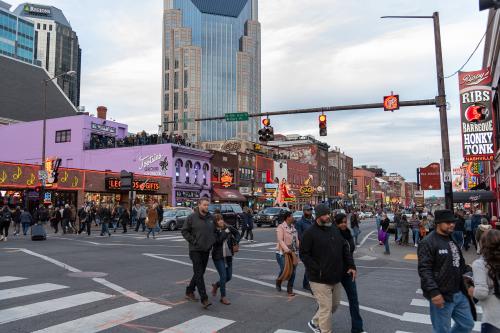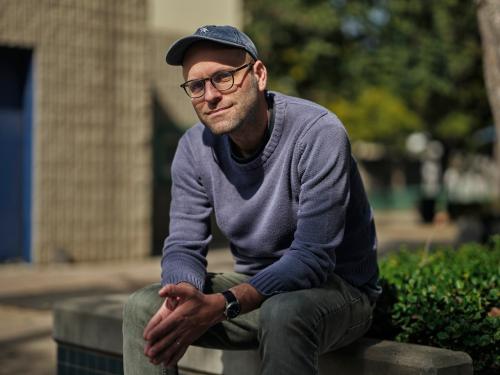What will our cities be in 25 years? The question calls up a caricature, a grotesque vision of ultimate ghettoization. The vision involves a permanent underclass of poor people, largely defined by race, in rotting urban enclaves with no public transportation worthy of the name. An affluent class lives far off in automobile suburbs, probably gated. A skyscrapered business center rises like a sterile Acropolis. Government is off in what it calls a “campus” somewhere. And all of it is spread out at regional scale, consuming enormous quantities of landscape, more like a small nation than the city as we have known it, and perhaps, like Miami today, with its own foreign policy.
To make something like this baroque vision come true, all we have to do, I suspect, is nothing at all. Any specific suggestion about how to make something else happen may sound paltry, because it will be bound by the limitations of the individual who makes it. But I want to suggest what architectural design might do, or has begun to do, to reverse the process of ghettoization, centrifugal dispersion, and sprawl. The New Urbanism tells us that the architect’s essential job has always involved the manmade environment as a whole, that we once knew quite well how to shape it and are now learning how to do so again.
I think first of Seaside on the Gulf of Mexico in Florida’s Panhandle, the first of more than a hundred projects designed by Andres Duany and Elizabeth Plater-Zyberk, an ideal community at pedestrian scale, put together with the grid and the radiating avenues of the classical American planning tradition and built up in the wooden vernacular architecture of the region. Small, rather haunting, and Chatauqua-like, with a seasonal population, Seaside is still very much a town, with the liveliest retail trade along the coast. It has been followed by such very different communities as Kentlands in the suburbs of Washington, D. C., also by Duany and Plater-Zyberk, largely constructed of brick with many row houses in the Georgian vernacular of the Middle Atlantic tradition; and Laguna West, near Sacramento, by Peter Calthorpe; Harbor Town in Memphis, designed by RTKL of Baltimore and Looney Ricks Kiss; Fairview Village in Portland, by Lennertz and Coyle with Bill Dennis; Reston Town Center by RTKL; and the beautiful I’On near Charleston, by DPZ and Dover Kohl for the developer Vince Graham.
All these developments are fundamentally towns, or the image of towns, although none of them except Laguna West yet includes an integral workplace. But the process is under way. Malls, for example, are being transformed into town centers, so returning the automobile world to the pedestrian, as in Mashpee Commons, Massachusetts; Mountain View, California; Chattanooga, Tennessee; and in greater Miami, where Dover Kohl is making a new downtown Kendall out of the old Dadeland Mall and its surrounding “big box” sites.
This has all been wildly successful so far in making towns out of suburbs, or towns rather than suburbs, for an affluent middle class. But the New Urbanism has always had its sights set on affordable houses and rental units along with the rehabilitation of center city and of low-income housing. Duany and Plater-Zyberk, for example, redesigned and rebuilt the blighted Central Neighborhood in Cleveland in a vernacular as lovingly assembled as that of Seaside out of the traditional house type of the area. Other examples include Ray Gindroz’s remakes of blighted housing in Pittsburgh, Charlotte, and Norfolk and a good deal of work under HUD’s Hope Six program: Peter Calthorpe’s Henry Horner Homes in Chicago; Amy Weinstein’s fine traditional scheme for Washington, D.C.; and Mayor Vincent A. Cianci’s initiative in Providence, where dysfunctional office buildings are being turned into housing.
The wider influence of the principles of the New Urbanism in the inner city is apparent everywhere. In New Haven, as in numerous other places, the high-rise projects of the bad old days have been torn down, as have many of their accompanying low-rise barracks.They are being replaced by three-story wooden, frontal-gabled houses much like the old nineteenth-century two- and three-family type that traditionally shaped the streets of New Haven and from which, in the 1970s, Duany and Plater-Zyberk began to learn their trade. The density afforded by that kind of housing, which is familiar and sympathetic to its inhabitants and their style of life, has proved high enough for most cities, and the process of healing that it entails does not have to include “projects” at vast scale. It is all very well for stylish architectural critics to write that center city ought to be deliciously gritty and tough. Its inhabitants prefer it gentle and calm.
From the New Urbanists we have learned that it pays to urbanize the suburbs, to build rational new towns, and to rebuild the poorest sections of our cities in the same way. A kind of brotherhood, long lacking, cannot help but develop. Yet everything still remains to be done to recreate the sense of community entire, to integrate housing with industry, as was so beautifully accomplished by the Emergency Wartime Housing of 1917-18, and to reintegrate railroads into the system, toward which Calthorpe’s studies have already made essential suggestions. Trolleys, once the most valuable and also the shortest-lived introduction into the urban fabric, need to be used once again. And all of that is built, unlike the automobile, on a pedestrian base, on the willingness of people to walk a little bit?and to live a good deal longer. It is clear that the New Urbanism has already managed to create, or to revive, the kind of town and city environment that most Americans at all economic levels love best, and that is the most important thing about it.
Another hopeful sign is that most Americans today, general public and involved professionals alike, seem to value mayors above any other elected officials. Mayors have generally embraced the New Urbanism, as has the National Trust for Historic Preservation, which works closely with them. The U.S. Conference of Mayors has also set a splendid record, conspicuously absent in the U.S. Congress, of civilized cooperation between members of different political parties. Indeed a new politics is alive among the mayors; it hardly matters whether one is a Democrat or a Republican. It is possible to endorse the New Urbanism either way. Does this comity also suggest a weakening of the national fabric? One thinks not. The reasons for it lie deeper. They have to do with a revival of what the city has traditionally meant to human beings. It has instilled in them a special sense of their communal power to create a manmade theater for effective action, keeping nature at bay, perhaps even affecting its implacable laws. This has been so from Uruk to Athens and to the pueblos of the American Southwest. Our rituals are different, but they still require a coherent urban structure for their stage. The principle of the walkable neighborhood holds strongest in the biggest cities of all. It still shapes human beings, and if its structure goes, much of what is most human about us goes with it. We have not yet found a substitute for it, certainly not in the television set and the computer, not in the mythical global community of the electronic climacteric.


Commentary
The American City in A.D. 2025: A Considered Opinion
June 1, 2000